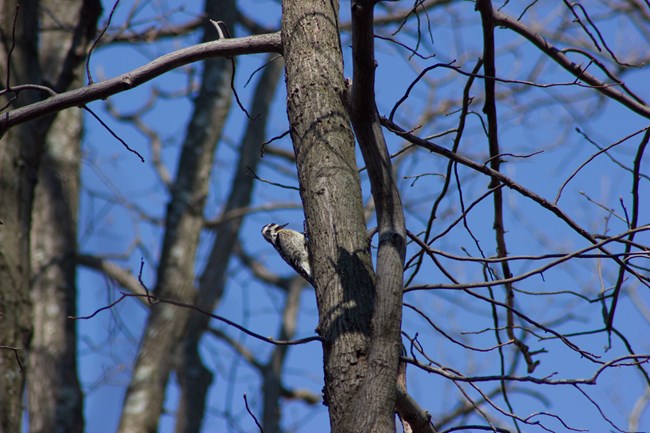
NPS Photo/Volunteer J. Chapman Downy Woodpecker (Dryobates pubescens)• Downy woodpeckers don’t sing songs but they drum loudly against wood or sometimes metal to achieve the same effect as singing.• These tiny woodpeckers mainly live in dead trees or dead parts of trees in open woodland areas but also live in orchards city parks, backyards, and vacant lots. • Downy woodpeckers mainly eat insects including some pest insects that live inside wood or trees but they also will eat plant material like seeds and berries 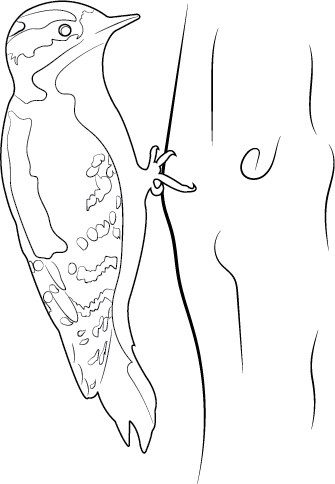
NPS/Intern Tristan Thomas Identification Information:• Size: Between a Sparrow and a Robin (Small)• Color: On their back they have a checkered black and white look with white spots on the wings. They have a white stripe on their back and are white on the belly. Males have a small spot of red feathers on the back of their head. 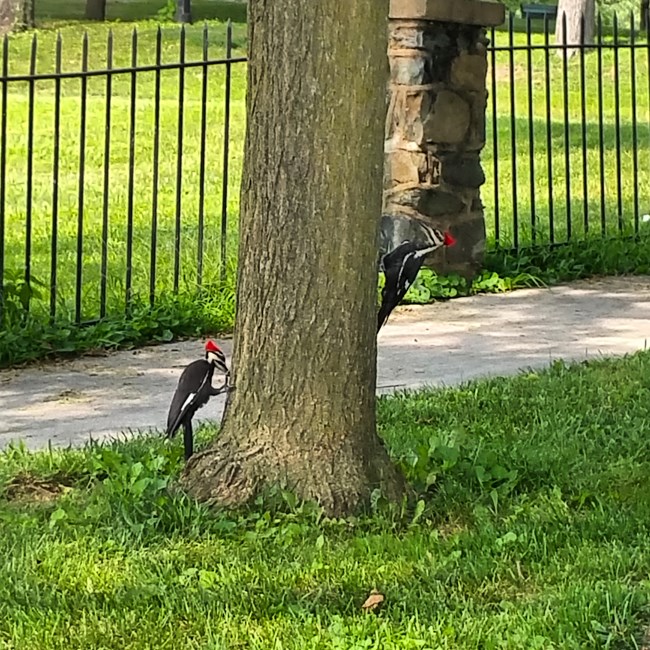
NPS Photo/M. Hammer Pileated Woodpecker (Dryocopus pileatus)• Pileated woodpeckers are very large and most distinguishable by the red mohawk on their head• Pileated Woodpeckers dig very recognizable rectangular holes in trees to find ants (see if you can find some woodpecker holes around the park) • They like to live in large, still standing dead trees 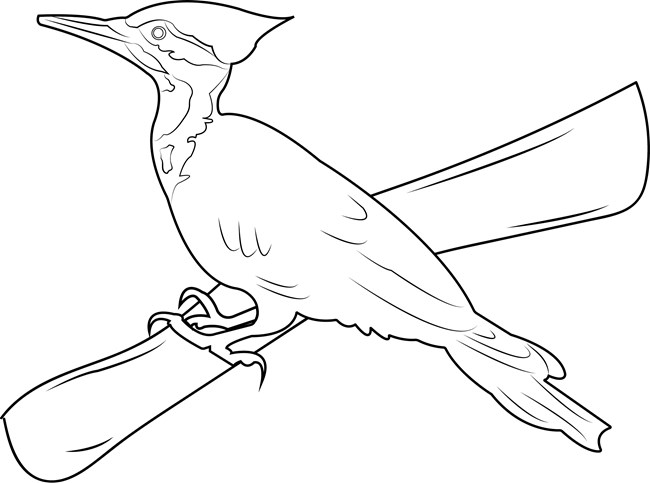
NPS/Intern Tristan Thomas Identification Information:• Size: Crow sized (Medium)• Color: Mostly black with white stripes on the face and neck. They have a bright red crest (mohawk) on their heads and males have a red stripe on their cheeks. In flight they have lots of white on the bottom of their wings. 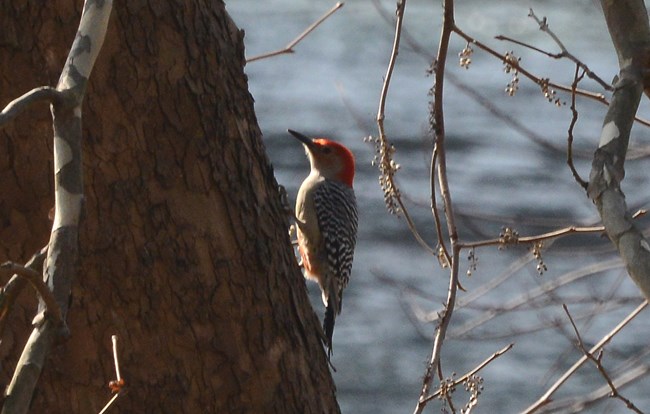
© Bill Telfair Red-bellied Woodpecker (Melanerpes carolinus)• Red-bellied Woodpeckers have really long tongues and can stick out their tongue about 2 inches past the end of their beak. The tip of their tongue is barbed and their spit is sticky which makes it easier to catch prey from deep in tree crevices.• When choosing a nest, males choose the next site and begin to carve out the site. They then try to attract a female by calling and tapping softly on the wood around the hole. When a female accepts this male, she starts tapping along on the tree and then helps the male finish carving out the nest. • Red-bellied Woodpeckers mainly eat insects and spiders but they also eat lots of plant material and will occasionally eat lizards, nestling birds, or minnows. • Sometimes you might see a Red-bellied Woodpecker putting large nuts into small holes in tree and then whack them into smaller pieces using their beak. They also use the small cracks in trees and fence posts to store food for later in the year. Identification Information• Size: Between a robin and a crow (Medium)• Color: Has a pale reddish/white coloring overall. They have a bold black and white striped back, a redhead and upper neck. They also have white patches near their wingtips that appear when they fly. 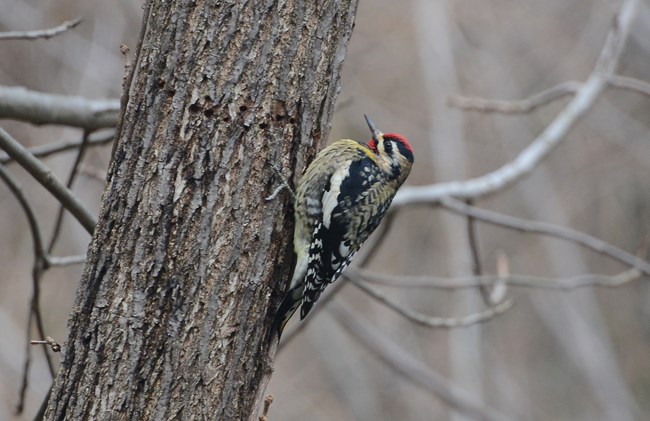
© Bill Telfair Yellow-bellied Sapsucker (Sphyrapicus varius)• Yellow-bellied Sapsuckers make two different kinds of holes in trees to get sap. They make round holes that go deep into the tree and are not very big. In this hole, sapsuckers insert their beak into the hole to look for sap. They also make rectangular holes that are shallower and must be constantly maintained for the sap to continue to flow. The sapsuckers licks the sap from these holes and eat the cambium of the tree. New holes are usually made in a line next to old holes or they create a new line above the old one.• The holes (sapwells) made by the Yellow-bellied Sapsuckers also attract hummingbirds that also eat the sap flowing from the tree. In some places, hummingbirds are so dependent on the sapsuckers that they time their spring migration to be at the same time of the sapsuckers. Other birds, bats, and sometimes porcupines also visit the sapsucker sapwells. • Yellow-bellied Sapsuckers frequently use man-made materials to help in its territorial drumming. They use street signs and metal chimneys to make their irregular tapping noises louder. There has been no evidence that whacking its beak on metal has negative effects on the bird and they will return to favorite signs day after day to pound out messages. • Sapsuckers usually choose sick or wounded trees for drilling their sapwells and they choose tree species that have higher sugar concentrations in their sap like paper birch, yellow birch, sugar maple, red maple, and hickory. Identification Information• Size: Robin sized (Small/Medium)• Color: Yellow-bellied Sapsuckers are mostly black and white with bold black and white stripes on the face. Both males and females have red foreheads and males also have red throat feathers. They have a long white stripe along their wing and yellowish/white bellies. 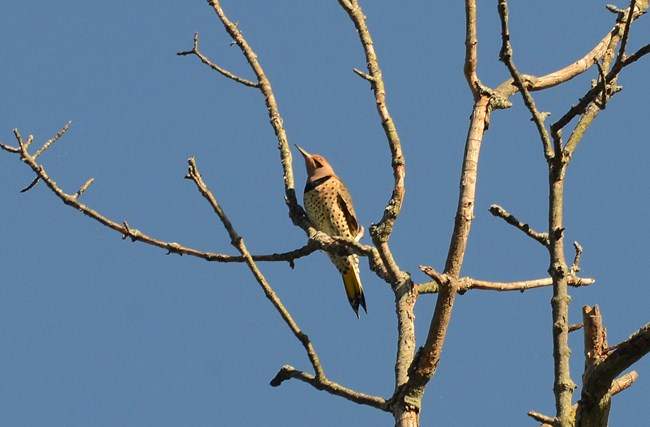
© Bill Telfair Northern Flicker (Colaptes auratus)• Although this woodpecker can climb up the trees and hammer the wood, they prefer to find food on the ground. Ants are their favorite food and the flicker digs in the dirt to find them. They use their long barbed tongue to lap up the ants.• Like other woodpeckers, Northern Flickers drum on objects as a form of communication and territory defense. They try to choose objects that make as much noise as possible and that’s why they sometimes choose metal objects. One flicker could be heard drumming on a tractor from a half-mile away. • When looking for mates, males display in a “fencing duel” where the two birds face each other with beaks pointed upwards and bob their heads while drawing a loop or figure eight pattern in the hair while also making calls at the same time. • Northern Flickers love to eat insects especially ants and beetles they gather from the ground. But in the winter they also like to eat fruits and seeds. To get to ants they often hammer at the soil the way other woodpeckers hammer into wood. Identification Information• Size: Between a robin and crow (Medium)• Color: Northern Flickers look brown overall and they have a white patch on their behinds that is visible when they are perched. The undersides of their wings and tail feathers are bright yellow for the eastern birds. If you get close enough you can see that their brown feathers are speckled with black spots, bars and moon shapes.
All of the above information is an abbreviated version of information gathered from the Cornell Lab of Ornithology. Please visit their website for more in-depth bird information.
|
Last updated: August 30, 2019
